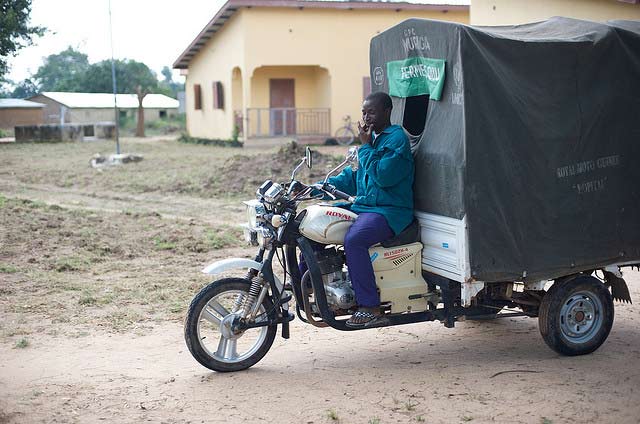We failed to meet the MDG target for reducing maternal mortality largely because our indicators were confined to proxy medical solutions (SBA deliveries and ANC attendance). We need to learn from the MDG underachievement. Conservative estimates showed that 130-180 million women were expected to deliver at home from 2011-2015 with 90% of these births occurring in rural areas.[i] This order of magnitude implies that in the short and medium term, the vast majority of maternal lives cannot be saved by the SBA strategy alone.[ii]
Timely emergency obstetric care evacuation with referral directly from the communities is an essential and feasible solution for saving the lives of the millions of rural women in low-resource settings. This emergency referral approach overcomes the first two delays of maternal mortality (delayed decision to access care and delayed arrival at the facility) and integrates rural communities with our successes in overcoming the third delay (delayed provision of quality care at the facility).[iii] Provision of community-based misoprostol significantly strengthens this approach by preventing rapid deaths arising from postpartum hemorrhage.[iv] Our e-poster at the Global Maternal Newborn Health Conference (GMNHC), Community Communication Emergency Referrals Save Rural Women, the Greatest Equity Gap, reports on a very effective community mobilization solution based on an innovative communication approach and tools that overcome the first two delays.
Our rural Community Communication approach contributed to saving thousands of maternal lives and increased the impact of the SBAs by 29% in a four-year UK Aid and Government of Norway project in northern Nigeria (Aradeon, S. B. and Doctor, H. V. submitted for publication).[v] Community Communication[vi] empowers low and non-literate women and men to become the communicators reaching deep into the community and making it easier for everyone to change. Instead of flip charts that remain with the health promoter, innovative communication body tools enable community members to lead informed discussions with small groups of their peers.
For one type of body tool, participants say some new health information and do something with their bodies to remember it. For instance, participants say “fever” while they cross their arms over their chests and shiver. Participants easily learn, recall and share the new information with friends and family generating social pressure for change. In the rural areas, we used Community Communication to catalyze establishment of community savings, transport and blood donor schemes. The return home alive of evacuated women rapidly increased community commitment to responsibility for ending maternal deaths.
In order to end the majority of preventable rural deaths, we still need a supplemental indicator to guide funders toward community mobilization for timely emergency obstetric and newborn care. For example, where relevant, governments and donors can establish the contribution of community mobilization to the number of lives saved by reporting on the number of emergency evacuations referred from specific communities triangulated with facility and transportation statistics that identify the evacuated women by name, community, complication and outcome. A similar approach can be established for newborn evacuations.
Data management was and will be a major challenge; however, the proposed indicator has the advantage of recognizing the contribution of communities, families and individuals—crucial components of the health systems that we will be strengthening. Hopefully we’ll see you at GMNHC where we can continue to discuss the importance and implementation of community communication approaches to save maternal and newborn lives!
Photo: “Motorcycle ambulance”© 2009 Julien Harneis, used under a Creative Commons Attribution license: http://creativecommons.org/licenses/by/2.0/
__
[i] Crowe, S., Utley, M., Costello, A. & Pagel, C. (2012). How many births in sub-Saharan Africa and South Asia will not be attended by a skilled birth attendant between 2011 and 2015? BioMed Central, Pregnancy and Childbirth, 12(4), retrieved from http://www.biomedcentral,com/1471-2393/12/4.
[ii] Aradeon, S.B., Aminu A. & Doctor H.V. (2014). Towards Better Solutions for Reducing Maternal Mortality and the associated Handout, Integrating Community Communication Into the SBA Model for Reducing Maternal Mortality, Presented at the American Public Health Association Annual Meeting, New Orleans, November 15-19, retrieved from https://apha.confex.com/apha/142am/webprogram/Paper315565.html
[iii] Thaddeus, S. and Maine, D. (2009). Too far to walk: maternal mortality in context. Soc Sci Med. 1994; 38(8): 1091-1110.
[iv] Wells, E. (2015). Put the power to reduce maternal mortality into women’s hands: Misoprostol. Maternal Health Task Force blog post, October 8, 2015.
[v] PRRINN-MNCH Program. (2013). Final Report 2013: Better Maternal Child and Newborn Health in Northern Nigeria. Available from http://www.prrinn-mnch.org/documents/PRRINN-MNCHFinalReport2013.pdf. Accessed July 11, 2015
[vi] Aradeon, S.B. and Soyoola, M. (2015). Part 0: Community Communication, in e-Manual for Community Communication: MNCH Interactive Health Promotion Sessions. http://healthcommcapacity.org/health-compass, Forthcoming.

